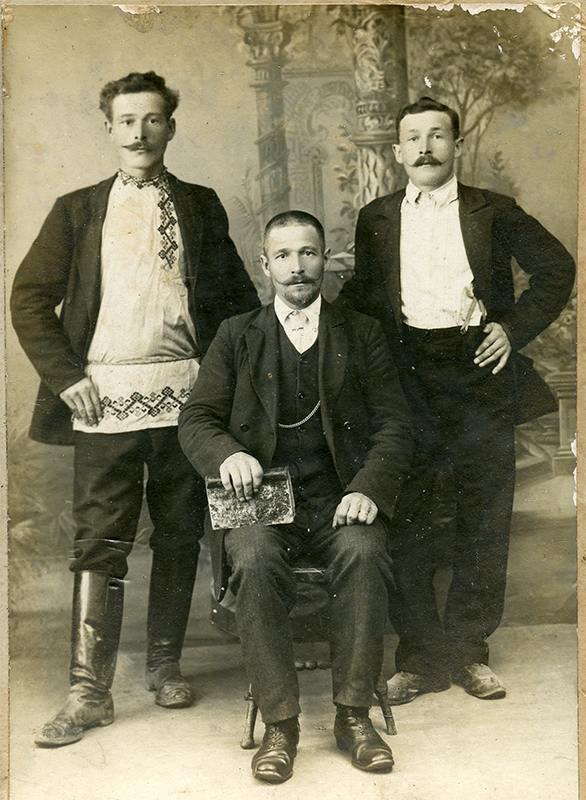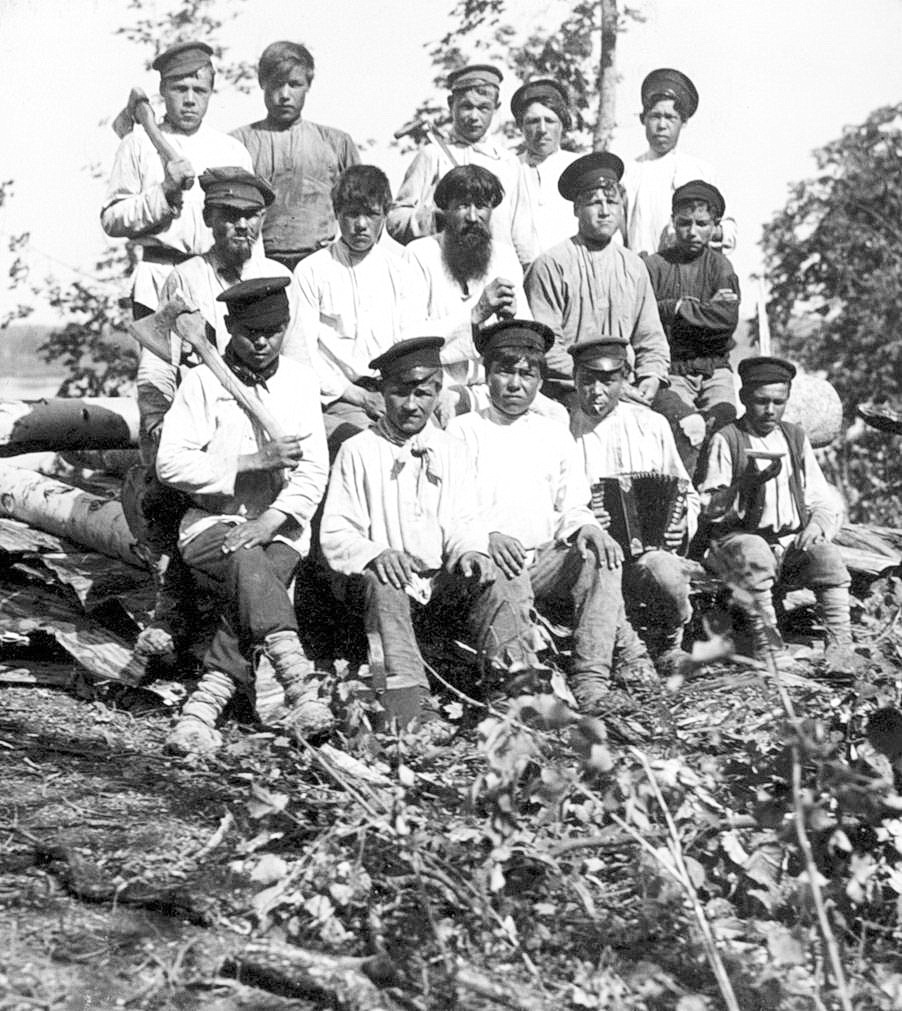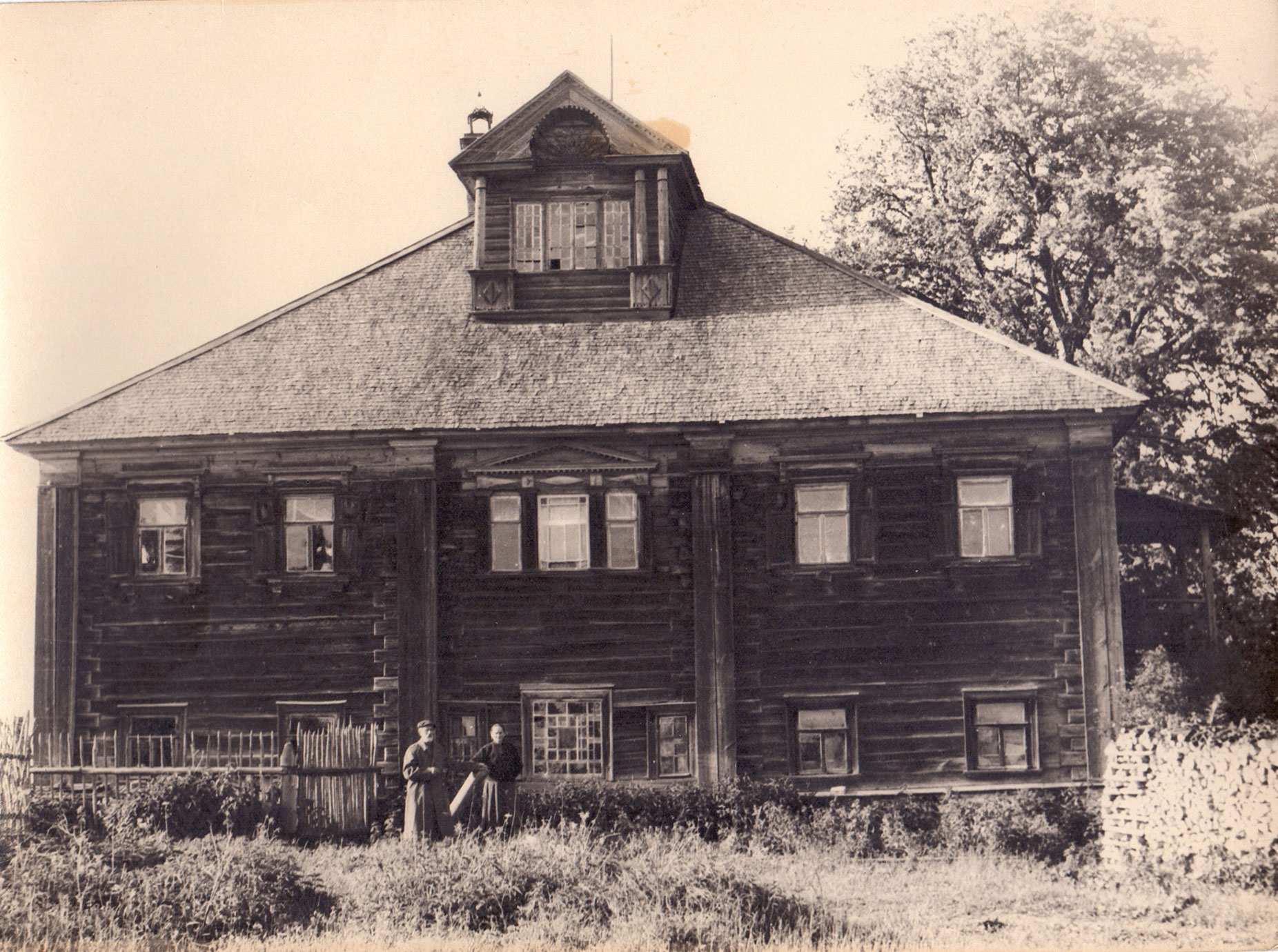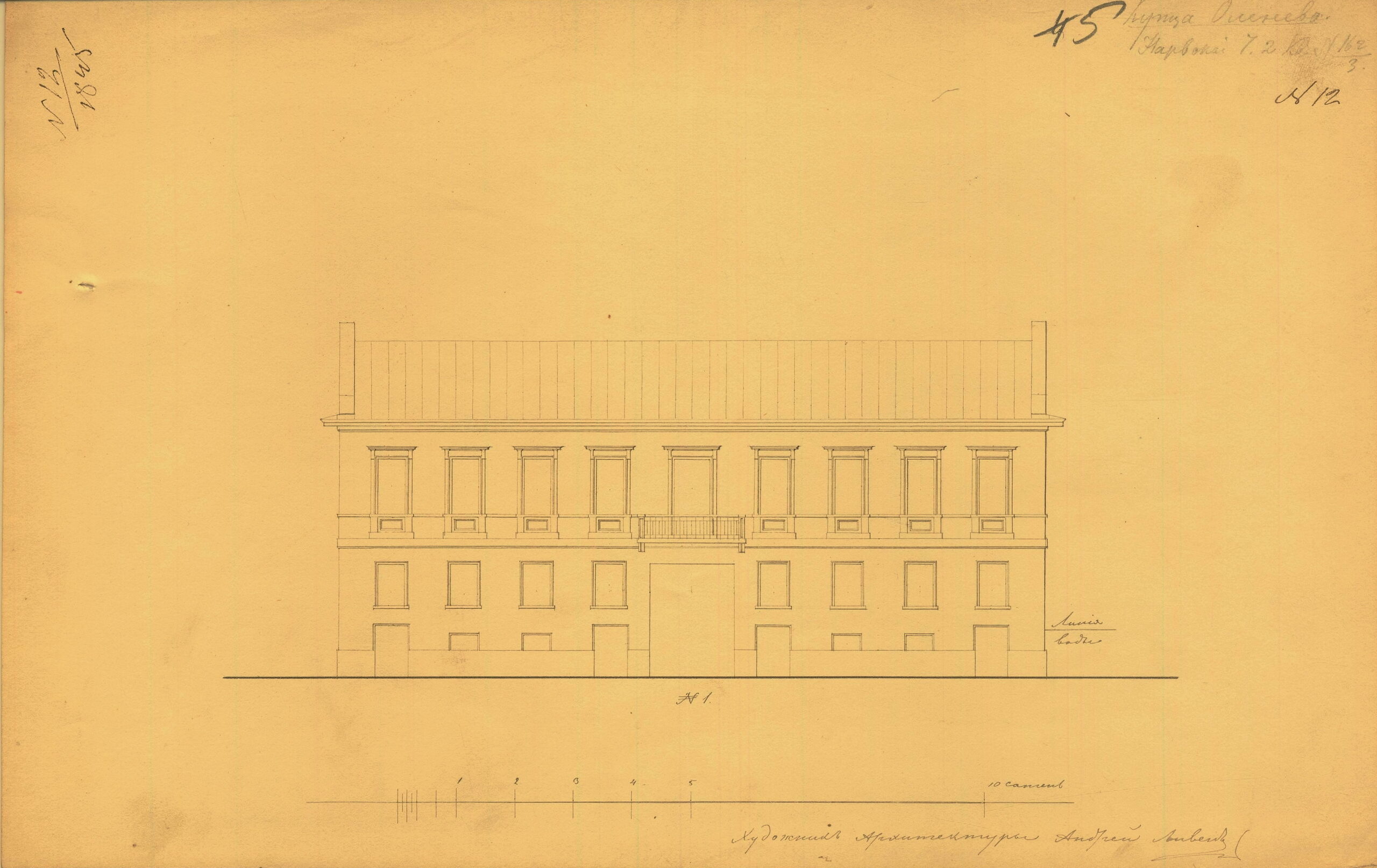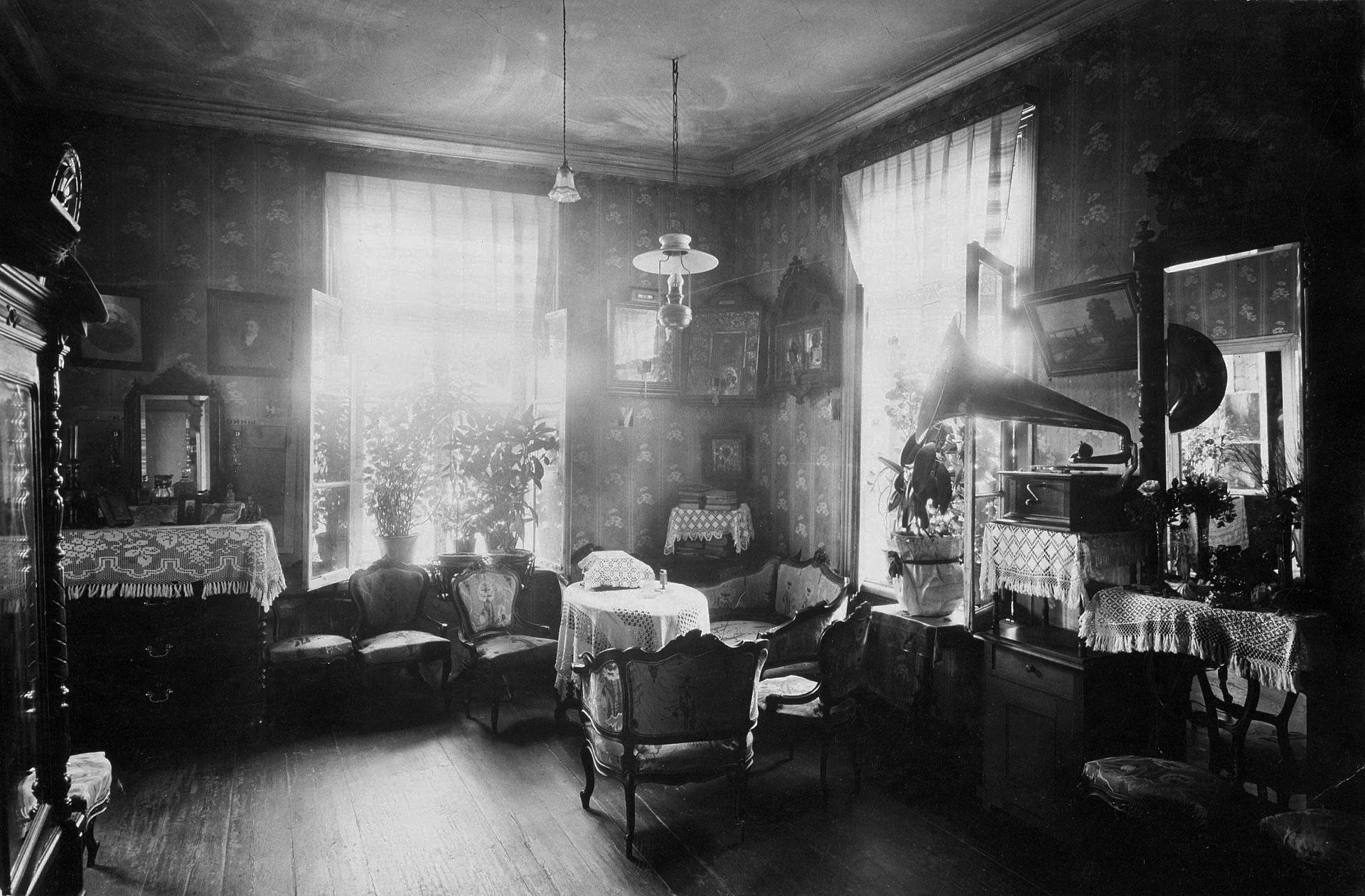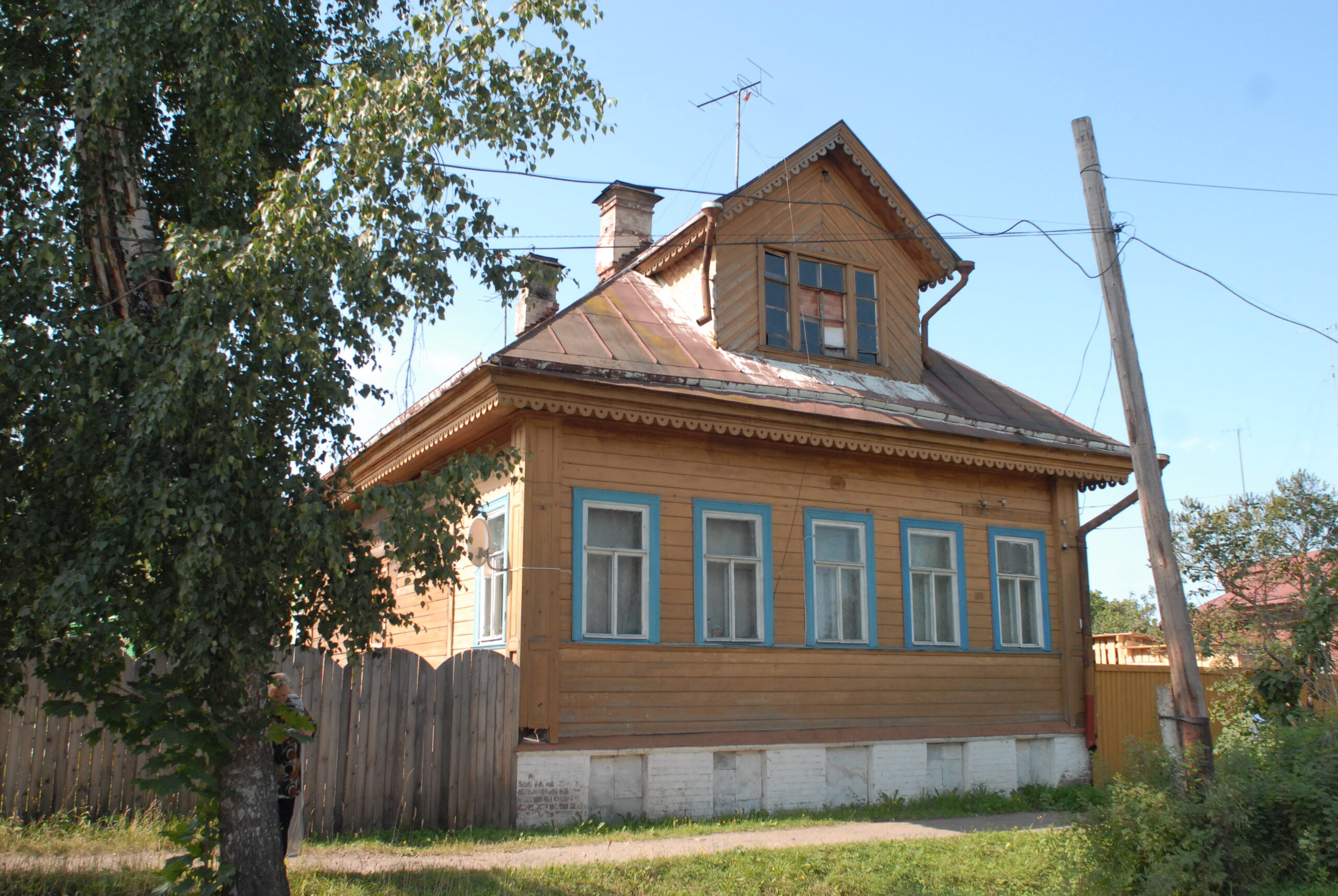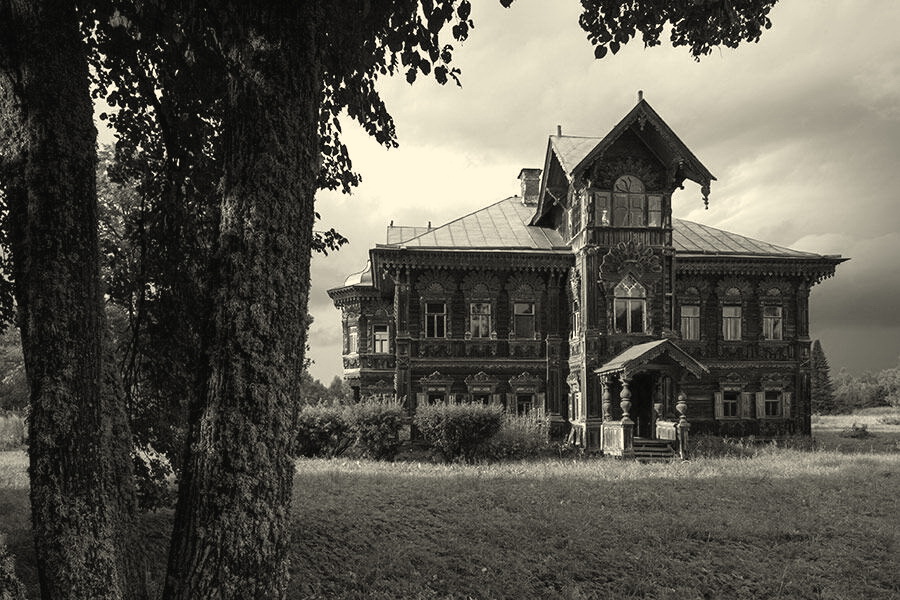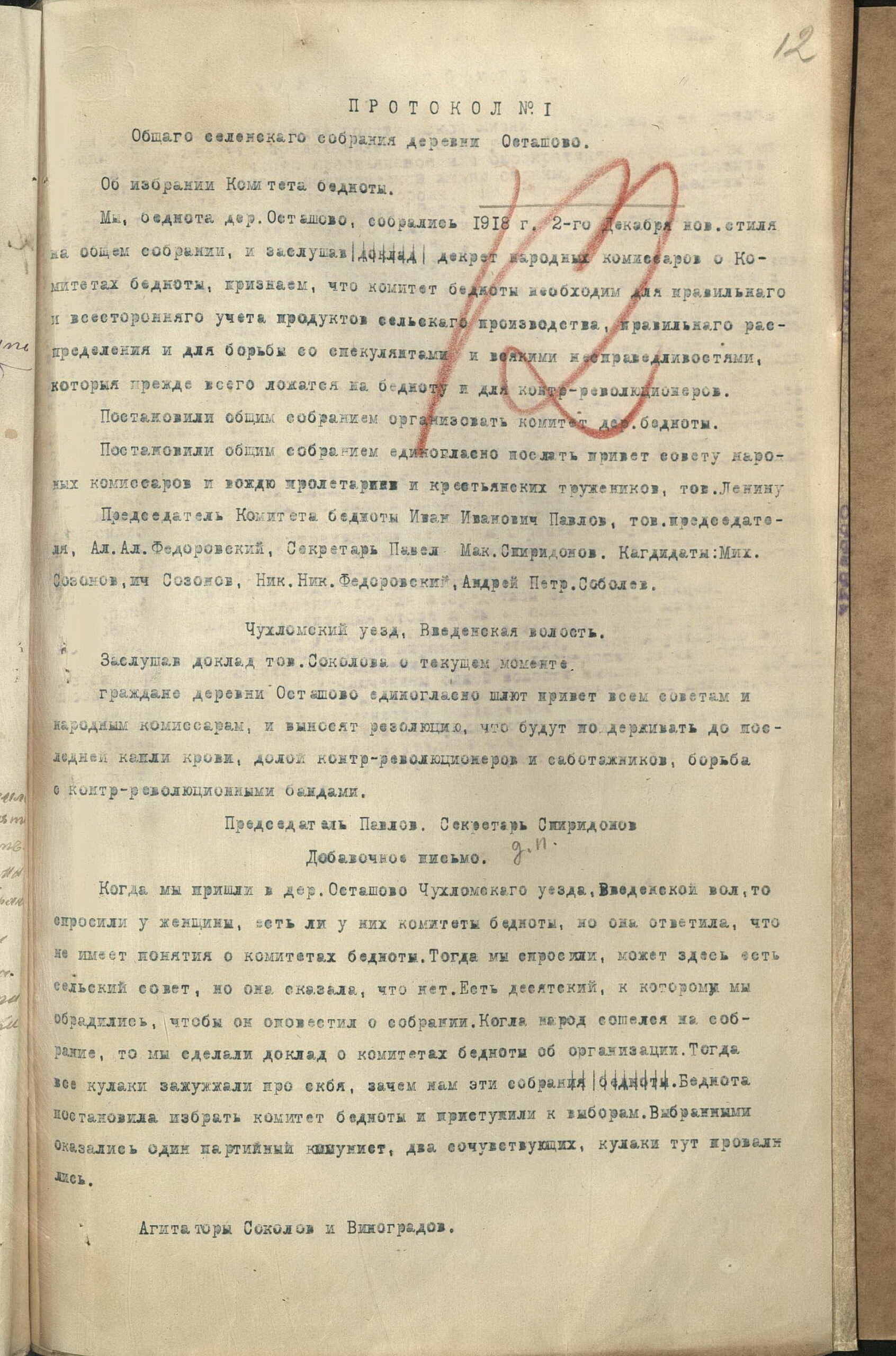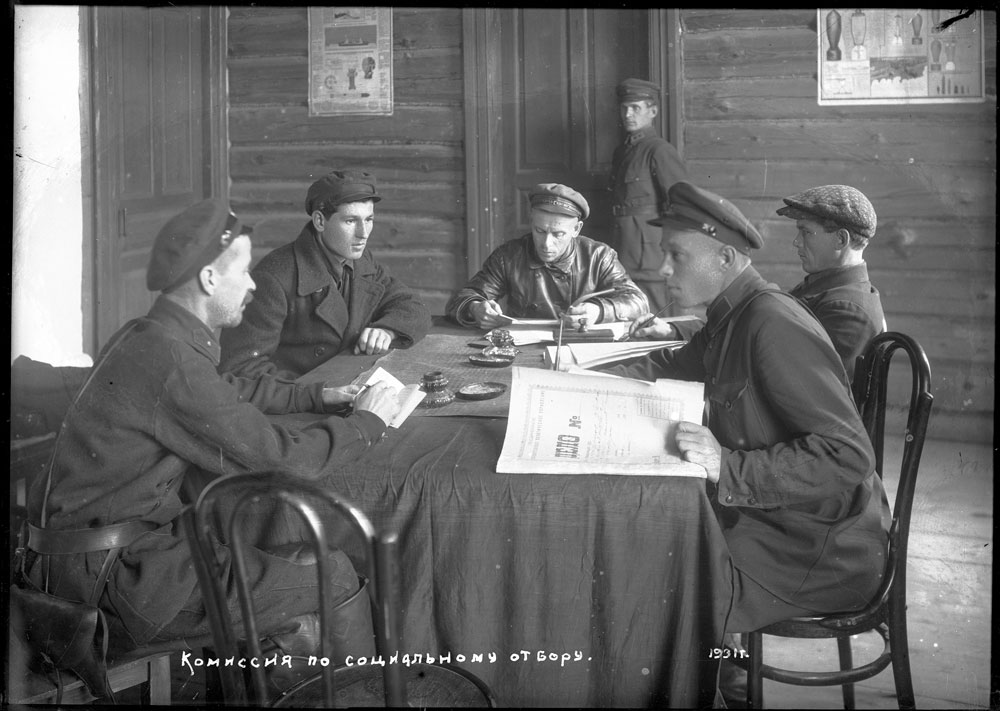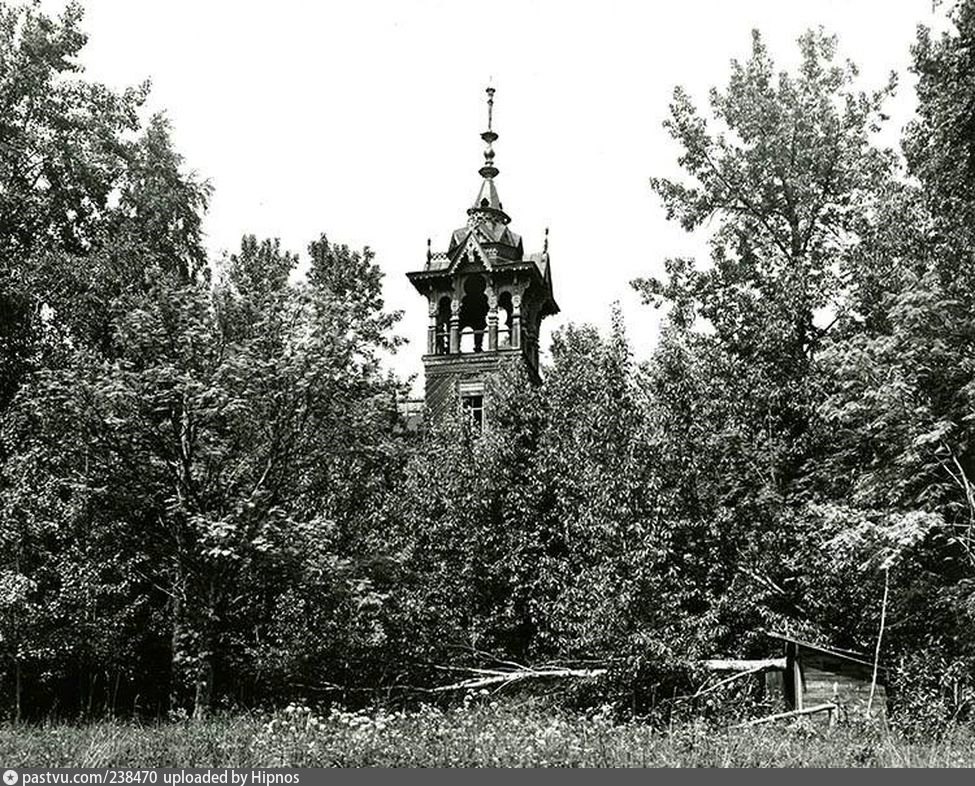The Terem of M. S. Sazonov in Astashovo; 1910s
History
Peasant’s Dacha
The Astashovo estate is unusual because it was not built by nobles, but by a former serf peasant, and combines the architecture of an exquisite country dacha with construction solutions and layouts that were typical for a peasant hut. The estate is located in the Chukhlomsky district, which “was considered to be the most remote district in Kostroma province” according to well-known philosopher and writer Alexander Zinoviev, who was born there. However, the district was also the most prosperous. Before the revolution, there were several estates that were equally as rich as Astashovo. All of them belonged to peasants and were located in their native villages. Where did the peasants get their money from? How and why did such luxury arise in such a remote place? What do we know about the culture that brought about the estate?
Between Village and City
In the 19th century, Chukhlomsky district was inhabited by seasonal peasant workers (otkhodniki). The otkhodniki were peasants who would leave their native settlements or villages for seasonal work (otkhod). The soil in Kostroma province is non-chernozem and barren, and this province was one of the top sources of seasonal workers in Russia. Makaryevsky district was known for its wandering felt boot makers (zhgoni). Men from Vetluzhsky rafted timber in Nizhny Novgorod. Residents of Molvitino were wandering artists who travelled around the Russian North and earned a living by painting. It was workers from Galich, Soligalich, and Chukhloma who “built St. Petersburg”, and this is not an exaggeration.
Almost all the workers from Chukhloma went to the capital (thus, they were called Petersburgers). According to censuses from the late 19th century, 95% of the local men had non-agricultural professions. They worked as painters, carpenters, joiners, carvers, turners, coffin makers, roofers, cabinetmakers, and plumbers. They set off for work at the end of winter and returned before Christmas. Peasants from Chukhloma spent a large part of their lives in St. Petersburg, often working as seasonal labourers from boyhood until they were 50-60 years old. These men would send their salaries to their wives and children, who stayed behind in the villages. Families were large, with as many as 15 children. Moving such a large crew to the city and feeding it there was impossible. Therefore, their loved ones waited patiently at home. Contemporaries snidely called the villages without men in the Chukhlomsky district “the women’s side”.
Skilled builders received about the same earnings as factory workers. Many seasonal peasant workers acquired a taste for city life and even wore jackets and topcoats in their villages and did not furnish their huts in the peasant manner, but rather in the bourgeois style. Contractors stood out among the ordinary craftsmen, and the most enterprising workers became contractors. Before the abolition of serfdom, landowners took up to half the earnings of seasonal peasants workers, but, even then, some contractors were so successful that they became richer than their landowners. By the end of the 19th century, contractors (there was one contractor for every two villages in Chukhlomsky district) could afford stone houses in the capital. Meanwhile, back home in their villages, they built carved wooden dacha-terems with parquet floors, mirrored walls, stained-glass windows, and with such an unheard of luxury as running water.

Markian Markov (later, Martyan Sazonov) is born

Martyan marries Anna Andreeva

The entire family moves to the capital

Death of his wife, Anna
Joiner Sazonov
In 1942, in the village of Astashovo, the first-born child of state peasants Sozont Markov and Yekaterina Avdiyeva was born. He was given the name Markian at baptism. His mother gave birth to him, like all peasant women, in a winter cow shed. When he was just three days old, the newborn was handed over to the midwife to take him three versts away to the parish Church of the Deposition of the Robe in Ozerki, the place where a monastery had once stood half a century ago. Surrounded by primeval forests on three sides, this now abandoned place where the newly christened Markian was born was called Pustinya. The midwife cut off a few hairs from the baby’s head, rolled them into a little ball with candle wax, and threw the ball into the baptismal font. The ball floated—this foretold a long life.
We worked with sources in Kostroma and St. Petersburg for several years, but we managed to find out just a bit about the first forty years of Markian Markov’s life (he was called Martyan Sazonov as an adult) – these were general descriptions of the life of seasonal workers from the Kostroma province and the St. Petersburg addresses of Martyan and his relatives. However, it was possible to restore a lot from the Chukhloma parish registers. For example, we found out that Martyan’s first wedding took place on Sunday, January 14, 1862, during the festive time between Christmas and Shrovetide. This is a traditional time for weddings among Petersburgers. Sazonov’s six children were conceived in winter and born in the fall at Astashovo. This means that during the 1860s-70s, Martyan, like other simple seasonal peasants workers, left his loved ones at home. It’s notable that during a time of high infant mortality, five children survived to adulthood, which indicates a certain level of wealth.
Old-timers in Pustinya say that Martyan had a furniture workshop but we did not find out anything about its registration. Martyan’s younger brother, Andrey, owned the joiner’s shops that were mentioned in the “All Petersburg” guide. His relative, Peter Osiev, also had his own joiner’s business, but he did not register his business and was regularly caught during checks and paid fines. Perhaps Martyan was more cautious, or he worked with one of his relatives on tribute. Osiev was the nephew of Akilina, Martyan’s favourite sister, who was the godmother of many of Martyan’s children and grandchildren. There was a legend going around Pustinya that it was Akilina who obtained the start-up capital for Martyan. She was said to have worked in St. Petersburg in the service of some factory owner. When the factory owner died, she took the bearer notes, about which none of the deceased’s relatives knew, and handed them over to Martyan. Such a story is characteristic of the village mythology about contractors. According to this mythology, contractors got rich either by deceiving others or by working in the Tsar’s palaces, and often, both these activities at the same time. We will never determine the sources of Martyan’s wealth. By the way, this is more typical rather than unusual for Russia. One way or another, in the early 1880s, Sazonov’s business affairs were on the upswing. In St. Petersburg, he buys a two-story house, No. 6 in the 12th company of the Izmaylovsky Regiment (present-day 12th Krasnoarmeyskaya Street) and moves his family from the village. Martyan and his family occupy one of the apartments in the house, and he rents the other apartments to his fellow villagers – a drayman, a furniture maker, and Peter Osiev. In 1887, Sazonov submits a request to build a laundry in the courtyard of house No. 6.
Unlike ordinary seasonal peasant workers, contractors lived in the capital almost constantly, visiting the village once a year. This was how it also was with Martyan until he suddenly did not return. The reason was most likely typhus. In terms of the spread of the disease, Russia was one of the most infected countries in the world, alongside Egypt and Mexico. The disease was not a companion to crop failure and wars—during the abundant and peaceful period from 1892-94, 430,000 people were sick with typhus in Russia. One of the victims of the epidemic was Sazonov’s wife, Anna. She died in February 1894 at the age of 52 at Martyan’s parental home in Astashovo. We don’t know for sure whether Martyan was there when she died or if he came to the funeral. But he did not remain a rich widower for long. In November of the same year, he married the beautiful Elizaveta Dobrovolskaya, the daughter of the deacon of the Church of Elijah the Prophet in Pustinya. She was 31 years younger than him.
In the Folk Style
After the wedding, the newlyweds, as can be assumed, went to St. Petersburg, but soon returned back. Perhaps Elizaveta Dobrovolskaya did not like the capital, or it was difficult for her to live with the Sazonov family. All Martyan’s children were older than her except for the youngest daughter, Lyuba, who was the same age. Well, whatever the reason, Sazonov and Dobrovolskaya decided to settle down in their birthplaces—in their own homes in Chukhloma and in Astashovo. But his father’s old hut did not provide status or suit Martyan’s urban habits. A new home was needed.
It’s no surprise that Martyan settled on a project in the “Russian style”, having chosen as the basis for his project a sketch of a country house published almost 20 years prior in the periodically released album Motives of Russian Architecture. In order to explain why Sazonov took a shine to this style, it’s worth saying a few words about it. In Russia, the works of Viktor Hartmann and Ivan Ropet, regular authors in Motives, are referred to as “Pseudo-Russian historicism”. The prefix “pseudo” emphasizes the fantastical origin of architecture. This type of architecture does not attempt to reproduce folk or pre-Petrine forms, but invents its own forms by borrowing motifs from book miniatures, embroidery, headwear, and clothes. The English name of the style is “Russian national revival”, which places it on par with similar trends in European romanticism of those times (Czech, Bulgarian, and other national revival movements). These movements fostered self-identification and created national “brands”. Hartmann and Ropet understood “Russian” to be something exotic. Their works are oversaturated with bright multi-coloured details—kokoshniks (women’s headdress in old Russia), towels, roosters, and unusual carved ornaments. Russia became known for this style, which was similar to theatre decorations, at international exhibitions in the 1870s and 1890s.
The Russian national pavilion at the 1878 World Fair in Paris was Ropet’s “Russian hut”. The “Russian hut” delighted the main art critic of those years, V. V. Stasov, who described it as follows: “A never-ending variety of windows, pilasters, carved ornaments, a row of fantastical birds holding twigs in their claws, varied kokoshniks and roofs, and, last but not least, richly coloured wood carvings of patterns and flowers, wide delightful carved cornices hanging from under the roofs like rich strings of beads on the forehead of a Russian peasant women, and towels hanging out of the windows like aprons on a sarafan.” An ideal peasant dwelling was decorated with an icon case filled with icons, a mirror with a towel and a brass comb on a string, a bed with bed curtains, a Russian stove with an oven fork, a poker, and a bread shovel, pots, earthenware saucers, and popular prints on the walls. Parisians were impressed by the oriental character of what they saw. Architectural theorist Eugène Viollet-le-Duc wrote a work in which he expounded upon his version about the Indian roots of Russian art.
This folk-style fantasy stepped out of the exhibitions into Russian daily life. The majority of projects published in Motives were too pretentious to be implemented entirely, but many of their separate elements ended up decorating country dachas, city estates, and fairground pavilions. However, by the 1890s, “Russian style” had managed to set people’s nerves on edge and was perceived by many intellectuals as kitsch, which was exactly what Sazonov wanted for himself. He drew inspiration from an 1877 sketch by Ropet, and chose to borrow from the sketch a turret with an unusual rim on its steeple and a kokoshnik-crowned attic room with a balcony and carved ridge on its roof. These bright details served to complete the slightly calmer facades in the eclectic style. It can be said with near certainty that Ivan Ropet himself had nothing to do with the alteration of his work. Elements from his projects were too widely used in buildings of the late 19th century to suggest that the architect was involved in even a small number of them. For example, we know of a dacha near the Moscow area that had the same turret as the Terem, which has now vanished.
However, the architectural forms thought up by Sazonov were too complex to use in the construction of a building without turning to the services of a professional architect, or, at least, an engineer. It seems that Martyan ordered the project or sketch in St. Petersburg and implemented it himself, without supervision, using his own peasant judgement. This is evidenced by a number of features. For example, the Terem did not have bathrooms, which, in the 1890s, were imperative for any city mansion or rich dacha. Instead, the owners used a slightly chilly toilet that was added on to the passage that led to the wing. There was no provision for a main staircase to the turret and the attic. Very heavy tiled stoves were placed on wooden floors—a traditional solution for wealthy huts in the Chukhlomsky district, but not the best building practise.
The exact date when the Terem was built is unknown, but it can be assumed that construction work began shortly after the wedding of Martyan and Elizaveta, and ended in 1897, when Sazonov appointed a manager of his St. Petersburg house and was elected to hold a village-level position by the peasants of Pustinya.

Martyan marries Elizaveta Dobrovolskaya (his second marriage)

Construction of the Sazonovs’ dacha – the Terem

Sazonov is elected as a desiatsky

Sazonov builds a parish school
Philanthropists
The Sazonovs lived in two houses. In addition to the Terem, Martyan owned a one-story mansion in Chukhloma – house 203 on Nikolskaya Street (present-day Lenin Street 30). In his home village of Astashovo he was elected for a position of desiatsky – a civil villager responsible for resolving minor disputes, order maintenance and similar duties too trivial for the police from the town to intervene. It required his presence in the village, and therefore, the Sazonovs were seldom in the capital, if at all, and they even sold their St. Petersburg home in 1907.
Nikolskaya Street is one of the district town’s central streets. The Sazonovs were neighbours with mayor Iyudin, the merchant Goloushin family, and with another successful contractor, Ivan Ivanovich Polyashov (Polyash). Martyan and Polyash were both friends and rivals.
However, his fortune and position in society greatly surpassed Sazonov’s. Ivan Ivanovich owned forests, land, two mills, a timber works, and small shops in the Chukhlomsky district. Sazonov’s social circle was limited to other migrant seasonal peasant workers and rural clergy. Polyashov made acquaintances among merchants and wealthy, distinguished townspeople. Furthermore, he was elected as head of Vvedenskaya volost (a volost was a small rural district in Old Russia). This was the most senior position in the system of peasant self-government, whereas Sazonov’s position as desiatsky was, on the contrary, the lowest rank (peasants’ “policemen” were appointed at the same village meetings as shepherds). Moreover, Polyashov was well known in the district as a philanthropist. In 1892, he built an elementary school at his parish church in the village of Dorok, became its trustee, and spent up to 105 rubles of his own funds on its annual maintenance. For his efforts, he was awarded a gold medal to wear around his neck on the Order of St. Vladimir ribbon and the title of personal citizen of honour.
Martyan seems to have been offended greatly by these awards. In 1904, he built a parish school at the Church of Elijah the Prophet in Pustinya, where his father-in-law had previously served as a deacon. A news article about this was published in the Kostroma Diocesan Bulletin. From this article, we know that Sazonov “acquired for the school an image of excellent artistry and two portraits of the Tsar-Liberator and presently reigning Sovereign Emperor Nicholas Alexandrovich Romanov”, sewed “clean school uniforms” for the students, organized a formal dinner party for inspectors and clergy in honour of the school’s opening, and submitted a notice about his desire to time the event to coincide with the birth of the Tsesarevich Alexei. After this, Martyan was indeed recommended for an award, but he was not presented with the gold medal, but received the silver medal “for diligence” to be worn on the Order of St. Stanislav ribbon. A year later, priest Vladimir Nazarov noted in his report that “the builder Sazonov is sad because other philanthropists received gold medals for similar sacrifices”.
Red Wheel
On August 1, 1914, a manifesto about the beginning of war with Germany was read out from the elegant forged iron balcony of the Chukhloma district council building to a crowd of townspeople waving national flags (the balcony has survived to this day). Due to the absence of lamp posts, the townspeople climbed onto drainpipes in a patriotic rage. The beginning of the Great, or Second Patriotic War, as the upcoming First World War was then called, had little effect on Martyan Sazonov. In the last years before the war, he was often sick, gained weight, had poor vision, and suffered from chest pains. He no longer made journeys from Chukhloma to the Terem, and lived in his house on Nikolskaya Street with his wife and their son Ivan, who suffered from consumption.
In Russia, you need to live long and die on time. Elizaveta Dobrovolskaya outlived her husband by 37 years, and Martyan’s special buddy and rival Polyashov outlived him by 22 years. During this time, they had so many troubles that they realized how lucky Martyan was. The Terem and the Sazonovs’ mansion on Nikolskaya Street were confiscated in early 1918. Elizaveta moved to the former home of her parents beside the Church of Elijah the Prophet in Pustinya. She lived in the house with her brother, who was a priest. Their father died in 1914, the same year as Sazonov. They were not paid any benefits. Before the church was closed, brother and sister only had the money received in church offerings to buy food for themselves, and relied on a vegetable garden and part-time farm later on. However, they were not left alone: the brother, as the servant of a cult, was deprived of electoral and civil rights, and his sons, who were also deprived of rights, tried to change their fate in 1930 by publicly disowning their father and starting a legal battle against him. After her brother’s death, Elizaveta Dobrovolskaya, as they say, became a freeloader.
Ivan Ivanovich Polyashov lost nearly everything: his terem, his house on Nikolskaya Street, the mills, the small shops, and the timber works. The generous Pogorelovo committee of poor peasants allocated him, his wife Mariya Nikolayevna, and their six children (the eldest daughter was 13, the youngest was 1 year old) 10 square metres of space towards the back area on the ground floor of their former home. Peasant living quarters were set up in the other rooms. The 70-year-old Polyashov even managed to work as a manager at his own mill—the new authorities had ran it into the ground and were forced to turn to him for help. Like other wealthy peasants in the past, the Polyashovs were stripped of their rights. In April 1930, Mariya Nikolayevna, who was deprived of her rights, wrote in a petition to re-examine her case: “I lived and worked by my own labour, because at the start of the revolution everything was taken from my husband, and I had to raise all my small children by myself.” Her blind husband died in 1936 at the age of 86. According to a family legend, on the day of the funeral, Mariya Nikolayevna was warned of her impending arrest, and she fled from Pogorelovo.

Death of Ivan (Martyan’s son)

Death of Martyan Sazonov

Terem was confiscated from his widow

Various institutions set up offices in the Terem

Terem abandoned due to its critical condition
Decline of Pustinya
After confiscation, the Terem at Astashovo was sealed and remained without an owner for over 20 years. We do not know the reasons for this; it’s one of the little mysteries that needs to be solved. The other wealthy houses we are familiar with were used for housing, schools, administrative purposes, or as utility rooms. During the time when the Terem was empty, life in Pustinya had not changed for the better. The revolution decimated private customers and undermined the economy of seasonal work. Former builders returned from Petrograd, invested their savings in agricultural equipment, and started farming.
The history of unsealing the Terem is worth its own summary. In the 1930s, the local village council was located in the village of Yushino in a house confiscated from affluent seasonal peasant workers. During the war years, the head of the village council was Tatyana Markova. The building in Yushino was dilapidated and unsuitable, but this was not the main reason that convinced the chairwoman to request that the house in Astashovo be transferred to the village council. According to old-timers’ tales, Markova promised her fiancé, who worked in the Chukhlomsky district military registration and enlistment office, that they would celebrate their wedding in the former living room of the Sazonovs. She had a reason to make an effort: it was 1943, and her betrothed was one of the few men who was not mobilized for the war. We know the last name of one of the men authorized to unseal the terem – Grafov. The only thing we know about the other one is that he smoked Kazbek cigarettes. However, the groom did not show up on the wedding day. A messenger with horses waited in vain for him at the agreed upon place. Then Markova set the village elders of Pustinya into action. Their delegation went to the military commissar and convinced him to offer his subordinate a tough choice: go to the wedding registry office or to the front. The groom went to the Terem under the escort of the village elders. The wedding took place, as promised, in the grand living room. The newlyweds lived together for two years. The military commissar fled from Markova shortly after the war ended.
The Terem was occupied by Soviet and collective farm institutions: a village council, a collective farm board (since the 1950s, a board of a state farm branch), a club, a post office (which also served as a savings bank), a library, and a first-aid station. The death of Stalin and the agrarian reforms initiated by Malenkov brought specific improvements. Local collective farms were reorganized into one major state farm with its central estate in the village of Vvedenskoye. Pustinya became one of the three branches of this state farm. They started to pay the peasants wages. The first reliable mass-produced tractors appeared. The capital construction of farms and housing began. But Chukhlomsky district remained, as previously, one of the most remote places in Kostroma region. It was only in 1967 that electricity was supplied to Pustinya, and the road here was built only at the end of the 1980s.
The other side of Malenkov’s reforms was that some of the restrictions on the movement of peasants were removed. Many of the residents of Pustinya perceived this easing of restrictions as a window, which, once opened, could be slammed shut once again. The 1950s and 1960s became the era when almost everyone left the village. People went to relatives who had been lucky enough to get to Leningrad before the war and survive the blockade. They made use of the quota for post-war settlement of the deserted northern capital. They left for construction sites and were conscripted into military service, learned trades while in the army, and stayed to work according to their professions in the cities. The population of Pustinya, having reached a peak of 4,000 residents around 1926, had dropped to several hundred by the early 1960s and continued to decline. The consolidation and liquidation of small settlements during the Brezhnev era was dictated by the reality of the depopulated place. In the early 1970s, most of Pustinya’s remaining population moved to the central estate of the branch in the village of Ilyinskoye (where Sazonov built a school in 1904). A new building of the village council was built here, and the Terem, whose roof was leaking desperately, was completely abandoned. This happened around 1973. Astashovo’s last two residents left the village in 1998. By this time, the state farm, having gone bankrupt in the early 1990s, was not functioning, farms and capital buildings were dismantled by scrap collectors, and fields were not cultivated and had become overgrown with forests. Pustinya had about 150 residents in 1990, but only a few dozen people by 2000. Today, there is only one resident living here permanently. Of the 34 villages, 29 have been completely abandoned.
Revival
The Terem’s restoration, which took place from 2010 until 2018, is not able to restore life to Pustinya and return the residents who have left. That was not the goal of the restoration. The task of our project is to preserve heritage. The century that has passed since the revolution was a difficult ordeal for all architectural monuments, but it was a true disaster for wooden architecture. In the 20th and early 21st centuries, Russia lost most of its urban wooden buildings and an overwhelming number of wooden estates. Examples of the Russian dacha style or Art Nouveau are becoming rare. In the whole country, there are not even hundreds, but rather mere dozens of such outstanding architectural objects as the Terem. Of the surviving architectural objects, many have underwent Soviet repairs or unscrupulous restorations and have lost the integrity of their interiors or their external appearance.
Last, but not least (and this is important for us!), our project is a memory capsule. This capsule contains information about Petersburgers and their vanished culture, which was a quaint mix of village and urban life. It also tells you about the grasping and ambitious peasant businessmen, who, if it wasn’t for the revolution, could have become an important part of alternative Russian history. This is also the story of an obscure place that was not marked on geographical maps but known by its residents as Pustinya. It is from the chronicles of such places that the history of our vast country takes shape.

Restoration of the Terem begins

Museum and hotel are open

